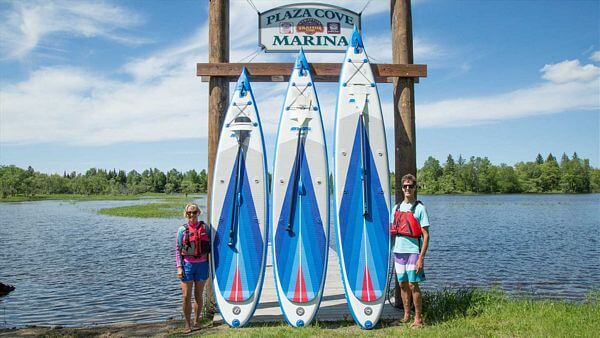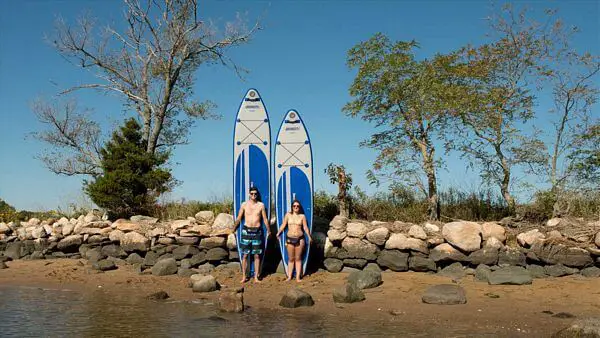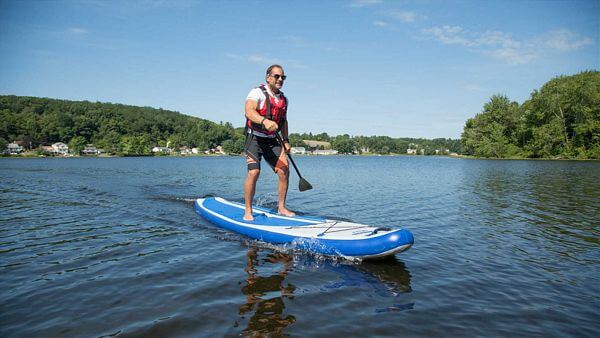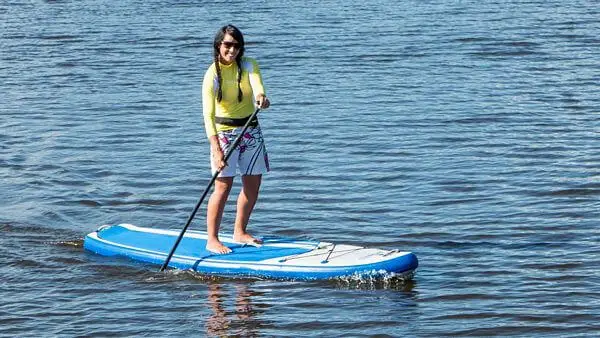This article is all about how to buy a SUP board, about choosing the best stand up paddle board for your needs.
Stand up paddle boards are not one size fits all. Don’t just go online or go into the store and buy the cheapest board you can find.
Read this article and it will help you choose the best board for you.
Table of Contents
Things to Consider

Some of the things to consider before buying a board are:
what are the conditions you’re going to use it in
what are the functions you want the board to perform.
Probably the most important factor in choosing a board is your height and your weight.
Third is your future goals. What do you want to do with the board in the future.
I’m gonna focus on all-round boards, hard boards.
If you are living in a place where you’re going to only paddle in flat water, like lakes, rivers, smooth water, no waves, then I would also recommend looking at touring boards, which have more of a pointy bow and a displacement nose that helps you go faster in flat water.
But if you want to consider using it in waves or in the ocean, I would definitely recommend looking at the all-round boards, which are the most popular boards to buy for beginners.
For many people the first choice is: should I get an inflatable or a hard board?
Inflatables are very popular. More about the pros of inflatables in another article. See Best Inflatable Paddle Boards.
Hard boards are another popular option.
Dimensions
So let’s get into the dimensions of the boards.
A lot of times people come into a shop and say: I want a 10′ 6” board. The length of the board is important but it’s not the most important thing when you’re choosing a board.
Width & Volume
What’s more important is the width and the volume of the board. That really varies with your weight, your height, your ability.
For beginners, we usually recommend a volume that corresponds with your body weight.
The volume should float about twice as much weight as your body weight.
So if you’re 200 pounds, you want a board that has about 170 to 200 liters of volume.
Roughly as a guide, you can use your weight in pounds and one-to-one to liters of volume. So 200 pounds roughly 200 liters, maybe a little bit less.
If you’re 120 pounds, 120 liters of volume is plenty for you.
That way the rails will be about half way underwater, which gives you a nice amount of stability.
If the board has too much volume you are actually higher off the water, which can make it less stable.
If you’re choosing a board for a family, for example, always use the heaviest, tallest person as a guide for choosing the volume and the width.
The width is also very important. a narrower board will be much more tippy while a wider board will have more stability because the width is what gives you the side-to-side stability.
It’s a very important number. A wider board will be more stable but a narrower board will be faster because it has less drag through the water.
For speed choose a narrower board.
We covered the volume, we covered the width, what about the length?

Length
The length is very important to look at as well.
A longer board will glide better and have better tracking. So if you want to go straight and you want to go fast, choose a longer board, it’ll help you go faster and glide better.
If you’re planning to surf, probably something 10’6″ or shorter will probably be best, because a shorter board will allow you to maneuver better.
It’ll allow you to turn around to catch the wave easier, it’ll turn easier on the wave and be more maneuverable. You can get on the back of the board and turn it off the tail.
For surfing, the shorter you can go and the lower volume you can go, usually the better for surfing. But don’t get a board that’s too small.
When you’re starting out, you want something that has enough volume and stability to paddle back out and easily catch the waves.
Many people make the mistake of buying a high-performance surfing model because they want to surf with it and then find out that it’s just too small for them to comfortably paddle on.
Design
Another really important aspect when you’re choosing a board is the design of the board.
The outline, the rocker line, the rail shape and the nose-to-tail tapering shape are all important.
The most important thing on a board which most people ignore is the rocker line of the board.
It’s that shape of the bottom contour of the board. It makes a big difference! A lot of rocker will turn easier on the wave but also be a little bit slower through the water, kind of pushing through the water more, versus a flatter rocker that will generally be faster. If it’s too flat though, it can also be slower.
It has to have a good rocker line that matches the water that you’re paddling on.
Too much rocker can be bad, too little rocker can be bad and the distribution of the rocker is very important.
It’s very subtle but makes a big difference in how the board handles.
On some of the cheap boards that aren’t designed well, just having the rocker being a little bit off, like a flat spot in the middle, or too much or too little rocker in the nose, too much or too little rocker in the tail, can make the whole board not work right.
In terms of outlines, let’s compare two models.
One is 9’6″ by 31″ by 160 liters and another one is 9’4″ by 33″ by a 140 liters.
The second one has a little bit more of a pointy nose, the first one has a little bit of a wider, rounded nose. It’s not a super wide long board nose, but it does have a little bit more volume in the nose and more width, so that helps draw that wide point further forward.
The tails are fairly similar on both models.
The first model has the middle part of the board that has a little bit of a straighter outline versus the second model, which is is more curvy.
The curviness will help you make it more maneuverable. If you’re on a wave, having a curvy outline and a pointy nose and tail will help you with turning. The nose also helps you prevent catching the nose in a turn.
When you’re going through whitewater, it goes through the whitewater and chops a little bit easier by just being able to punch through the water a little bit easier, versus a wider nose that gives you more stability, better tracking with that straighter outline.
Better stability for the same width, but sometimes that wide nose can get caught in the whitewater, if you’re going through whitewater. Also if you’re going through choppy water, sometimes it can have a little bit more drag on the chop in the water because you just have more surface area in the nose.
But the advantage of having a wider nose or a wider tail is that it brings that wide point more forward and more back so it has more stability at a certain width, versus a more curvy shape with a pointy nose and tail, where you’ll need a little bit more width in the middle to make up for that less stability in the front and the back of the board.

Rail Shape
Let’s take a look at the rail shape of these two boards.
The second model has a really thin rail shape. It has a real thinned out rail versus the first model that has a little bit of a fuller rail so it has more volume in the rail.
The thinner rail helps in the surf because it lets you sink into the turn a little bit more, gives you more grab on a wave.
A thinner rail will be more high-performance, especially in the tail. You want a thin rail because that helps with turning and carving versus having thicker rails with more volume will make the board a little bit more stable as you have more thickness.
Also I would say it’s a little bit more forgiving, it doesn’t carve into the turn as much, but it’s little bit softer in the turn.
So thinner rails are more high-performance surfing type of boards. Thicker rails are a little bit more forgiving, more all-round, a little bit more stable and they have more volume in the rails.
Goals
Another important thing to consider are your future goals.
Depending on what you want to use the board for.
Is it just casual use on weekends with the family and you just want to cruise, than a more stable, more user-friendly board is recommended.
If you do want to advance quickly and you are planning on paddling a lot and maybe going in the surf, you might want to consider getting a more challenging, more high-performance board right from the start.
At the same time make sure you don’t go too advanced.
Many people make the mistake of buying a high-performance board that’s made for a much more skilled rider before they have the skills and then it’s get frustrated and don’t use the board.
Make sure you get a board that’s suitable for your needs!
We always recommend getting a board that’s a little bit challenging at first because your balance will improve quickly. You don’t want to outgrow your board too fast.

Budget
Another really important thing to consider is your budget. And the availability of boards in your marketplace, and then the value you get for your money.
Some people say lightweight, strength, low price. Choose two out of three. You can have lightweight and low price. You can have strong and low price, but you’re not going to get all three together.
To make a board light and strong, it’s gonna be a more expensive board.
You can make an inexpensive board that’s lightweight by just adding less material, but it’s not going to be durable, it’s going to be very fragile.
You can make a board very strong by just adding more material, adding more layers of glass, which is not expensive. So you can have a board that’s inexpensive and strong but usually it’s not gonna be lightweight.
So it’s a trade-off!
If you want a very light construction, go with like a carbon fiber construction or PVC sandwich construction, light and strong.
Sandwich construction is where basically the layers of glass are separated and that construction is going to be stronger but also more expensive.
Try It
Another very important point is try it as many boards as you can before making a buying decision.
It’ll give you a much better idea of what kind of volume, what kind of width and length works for you, what kind of shape works for you and so on.
Many people buy a board sight unseen, order on the Internet and then they find out it’s a waste of money because it’s not the right board for them.
Don’t make that mistake.
Some stores offer SUP clinics. They put all their rental boards on the beach and let customers demo them. That’s an excellent way to try many different boards all at once.
Some stores also offer a try before you buy rental program. You can rent boards, try out different models and then apply the rental fee as a credit towards the purchase.
Or you can take a lesson with an instructor and the instructor can bring a couple different boards that you can try and see which one you like better.
Those are some good ways to try different boards before you make the buying decision.